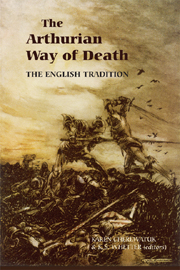Book contents
- Frontmatter
- Contents
- Illustrations and Tables
- Dedication
- List of Contributors
- Introduction
- Part I The early Tradition in england
- Part II Middle English Romance and Malory
- 4 ‘Hadet with an aluisch mon’ and ‘britned to noℨt’: Sir Gawain and the Green Knight, Death, and the Devil
- 5 Love and Death in Arthurian Romance
- 6 Death in the Margins: Dying and Scribal Performance in the Winchester Manuscript
- 7 The Legible Corpses of Le Morte Darthur
- 8 Malory and the Death of Kings: The Politics of Regicide at Salisbury Plain
- 9 ‘Layde to the Colde Erthe’: Death, Arthur's Knights, and Narrative Closure
- Part III Medieval Influence and Modern Arthuriana
- Index
- Arthurian Studies
7 - The Legible Corpses of Le Morte Darthur
from Part II - Middle English Romance and Malory
Published online by Cambridge University Press: 12 September 2012
- Frontmatter
- Contents
- Illustrations and Tables
- Dedication
- List of Contributors
- Introduction
- Part I The early Tradition in england
- Part II Middle English Romance and Malory
- 4 ‘Hadet with an aluisch mon’ and ‘britned to noℨt’: Sir Gawain and the Green Knight, Death, and the Devil
- 5 Love and Death in Arthurian Romance
- 6 Death in the Margins: Dying and Scribal Performance in the Winchester Manuscript
- 7 The Legible Corpses of Le Morte Darthur
- 8 Malory and the Death of Kings: The Politics of Regicide at Salisbury Plain
- 9 ‘Layde to the Colde Erthe’: Death, Arthur's Knights, and Narrative Closure
- Part III Medieval Influence and Modern Arthuriana
- Index
- Arthurian Studies
Summary
In Malory's ‘Tale of Sir Gareth’, the eponymous hero confronts a grisly sight during his first quest. As Gareth draws nearer to the enemy who is the object of his mission, the Red Knight of the Red Lands, he comes upon a plain where he sees the bodies of forty knights hanging from trees: ‘there hynge full goodly armed knyghtes by the necke, and their shyldis aboute their neckys with their swerdis and gylte sporys uppon their helys’. Sir Gareth lowers his face at the sight and asks: ‘What menyth this?’ Though still a young knight newly dubbed by Sir Lancelot, Gareth has already seen his share of deaths in battle, having himself dispatched a few prior foes with nary a qualm or a question. But this shameful display of knightly corpses gives him pause, not least because it does not fit the standard model of how knights are supposed to be killed or how their corpses should be treated.
When his companion Lynet answers his question by saying that all the victims of the Red Knight are served thus, Gareth says, ‘Now Jesu defende me … frome suche vylans deth and sh[e]ndeshyp of harmys, for rathir than I sholde so be faryn withall I woll rather be slayne in playne batayle’ (320.11–14). Such a death in battle is not only more honorable than a lynching, it is also more readily intelligible as part of the system of chivalry, which offers a code for the practice and understanding of violence, particularly violence in battle.
- Type
- Chapter
- Information
- The Arthurian Way of DeathThe English Tradition, pp. 124 - 135Publisher: Boydell & BrewerPrint publication year: 2009



